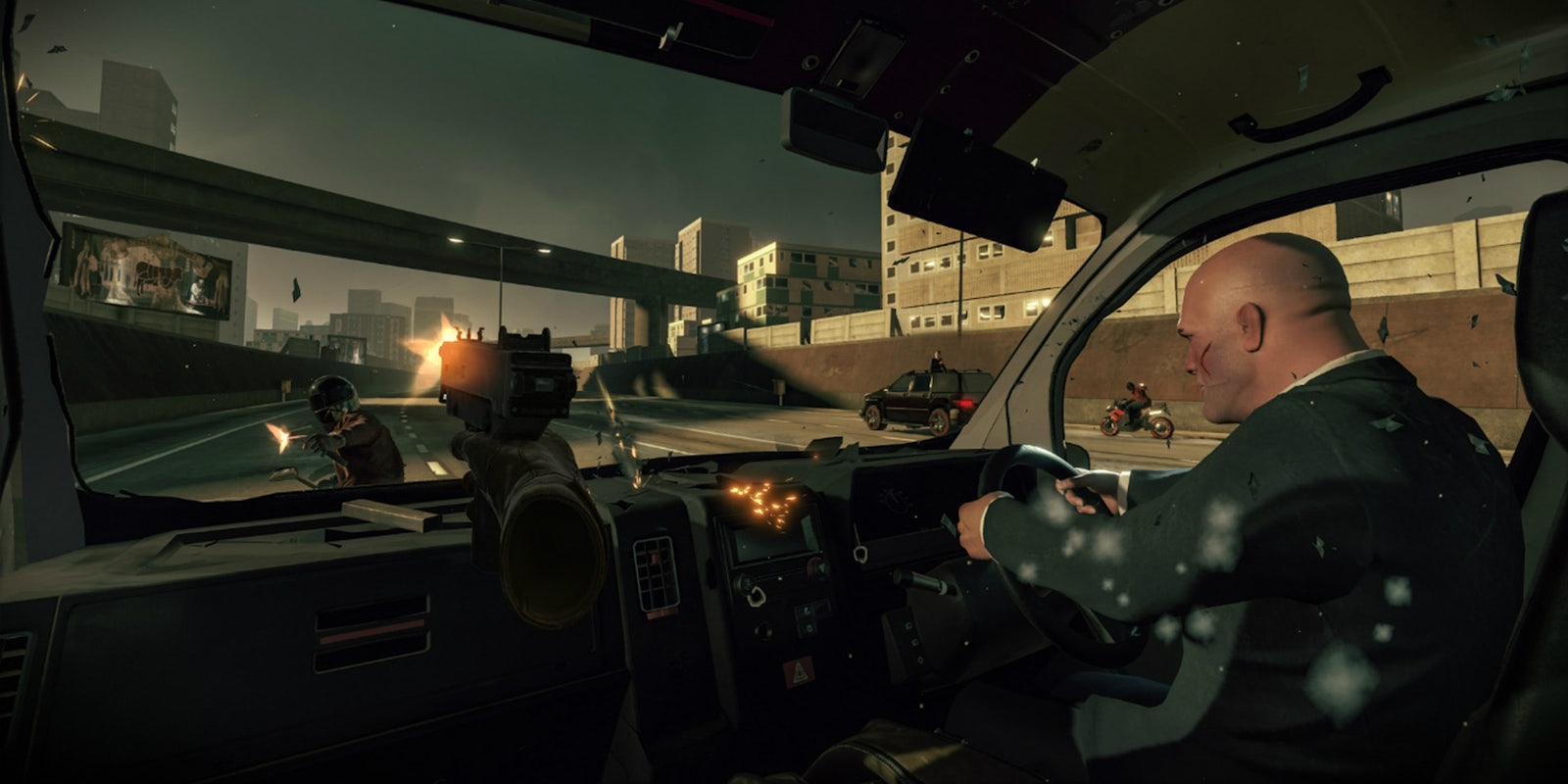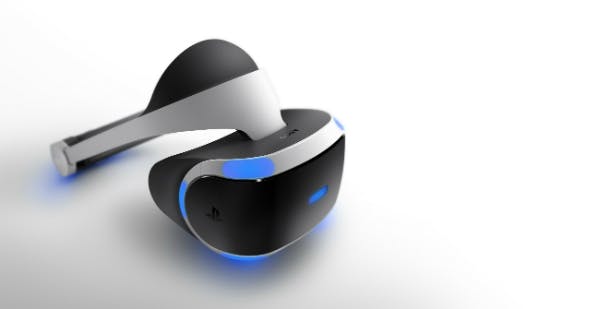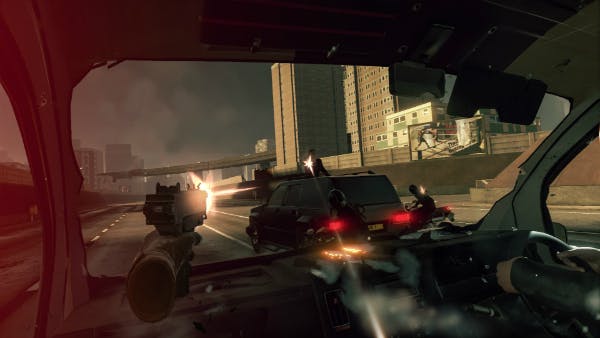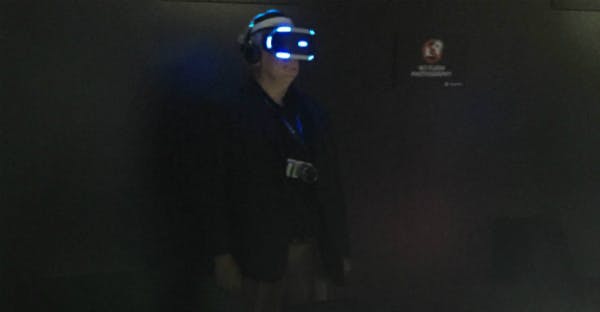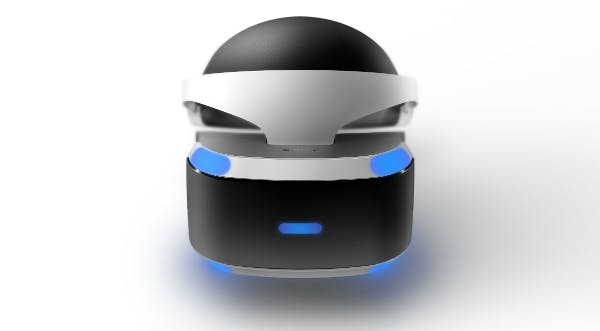A bald-headed driver with a working-class British accent, a black suit, and driving gloves sat behind the wheel as our van tore down a four-lane highway. He said something to me about how I’d shot up a place, talking in a gravelly tone that said “bad guy.”
I wasn’t paying much attention. I was busy opening the van’s passenger door and tossing ammunition magazines out onto the swiftly passing pavement, grabbing mags from the duffel bag that sat between the driver and me.
If you want to test the limits of a virtual reality demo, the first thing to do is all the stuff you’re probably not supposed to.
This was my first demo of Project Morpheus at Sony’s July Holiday Showcase event last week in New York City. The virtual reality hardware is due to ship for the PlayStation 4 in 2016, and Sony is eager to show it off. The white and black VR rig looks toyish compared to the more somber Oculus Rift DK2 or HTC Vive headsets I’d tried in the past.
I found the aesthetic appropriate, in retrospect. After trying three games at the event I felt like I’d played with Morpheus. The other two VR options felt like more of an experience than a game.
The quintessential problem with virtual-reality shooter games is the question of movement, and how anyone can replicate the running, jumping, diving, and shooting that players demand of their shooters. The London Heist: The Getaway deals with this conflict by letting you ride shotgun in a getaway van following a bank heist.
A PlayStation Move controller in each hand, in the real world, projected my virtual hands into the van I was virtually sitting in. I had to test how accurate the movement was—whether I felt a 1:1 ratio between my movements in the real world and my movements in the virtual.
It’s the first, key component in designing a compelling VR experience, so I tested it by squeezing the triggers of the Move controllers as I grabbed objects within the simulation, tossing the magazines out of the van and leaning out to make sure they hit the street and quickly vanished from view as we drove on. They did.
I picked up a fast food drink container and a can of soda on the floor behind the driver and tossed them around. Simple physics tests like this define the limits of a virtual space, and The Getaway passed early inspection with flying colors. I returned to the bag of ammunition and tried to stack magazines on top of one another, on the dashboard.
“You might want to stop throwing away all that ammunition. You’re probably going to need it,” said my guide from Sony just before I heard gunshots. I saw tracer rounds whipping up from behind us, and the driver handed me a gun.
Sony first revealed Project Morpheus on March 18, 2014, at the Game Developers Conference in San Francisco. “You knew this was coming, right?” Shuhei Yoshida, president of Sony Computer Entertainment Worldwide Studios, said at the time. It turned out that Sony had been experimenting with VR since 2010 following the development of its motion-control gaming solution, PlayStation Move. The evolution, in retrospect, does seem obvious.
The PlayStation Camera can track the Move controller’s position in 3D space using light, generated by brightly glowing bulbs at the top of the controller. The PlayStation 4’s DualShock 4 controller has a similar functionality via a light bar at the front of the controller. The Project Morpheus rig is dotted with glowing lights for the same purpose. Sony has essentially had the raw components of its Project Morpheus technology for half a decade.
The Morpheus prototype I demo’ed was “close” to finished, I was told. I wore headphones instead of integrated audio, but Sony would not say if that would be coming in the final version of the gear. Morpheus is the least heavy of all the VR rigs I’ve sampled. I wouldn’t go so far as to call it comfortable.
The first thing I do when I strap a VR headset on is determine whether or not my eyeglasses are in the way, and how much they get smashed into my face as I tighten the headset’s fit in order to prevent light leakage.
Prior to the beginning of my demo for The London Heist: The Getaway, I could too easily see the glowing bulbs atop the pair of Move controllers I was holding in my lap. I tried to tighten the unit to block out the light to little avail.
The piece of material at the bottom of the Morpheus goggles that runs across your nose has a lot of give to it. This lends itself to comfort. The eye-well depth—the amount of free space around your eyes when the rig is strapped on securely—is generous. Both facets of the rig also meant that when I adjusted the fit of the Morpheus rig as tight as I could without smashing my glasses into my face, the rig was still too loose at the bottom to make a tight seal.
People who wear glasses might have to deal with “good enough,” when it comes to VR technology. The good news is that my awareness of the light leakage melted away during my first Project Morpheus demo, in the face of shooting the bad guys on motorcycles and hanging out the windows of black vans as they tried to kill me.
After I tested the physics of the items within arms’ reach, The Getaway demo turned into a de facto session of the arcade game Time Crisis. Instead of standing in front of an arcade cabinet and pointing a plastic gun at a screen, I was using the Move controller to aim a virtual mini-Uzi machine pistol within the demo. To reload the weapon I had to grab one of the spare magazines in my left hand, move it toward the bottom of the gun in my right hand, and approximate the motion of sliding the magazine home. This was extremely satisfying.
I shot motorcyclists dead, sometimes taking out their wheels to make their bikes careen into the walls. I sniped at shooters hanging out the windows of black vans, shot out their wheels, and took out the drivers where I could for insta-kills. I spaced out killing my attackers with liberally spraying bullets into the dashboard and the ceiling and the partition behind me, to see whether all the materials took appropriate bullet damage. They did. Luckily, my driver did not.
I ran the demo a second time, and my guide from Sony pointed out some of the interactivity I hadn’t tried the first time through, like adjusting the vents on the air conditioning, fiddling with the radio knobs, and opening the glove compartment where I found ammunition that I stacked on the dashboard for easy access later.
I hadn’t done much by way of aiming the first time through the demo. I’d used tracer rounds and short, controlled bursts to hit my targets. The second time through, I tried aiming down the sights. I rested the knuckles of my right hand against the blade of my upturned left palm, as if I were cradling the mini-Uzi in real life.
The demo was too chaotic for me to judge whether or not I was getting any increased accuracy or stability versus adjusting my fire based on where my tracer rounds were landing. More interesting was the fact that I played like crap the second time through because I was thinking too much about assessing the simulation. The first time through I just abandoned myself to the illusion.
Super Hypercube
I whistled the theme song to Tetris during almost the entirety of my first demo of Super Hypercube, because the two games work on the same, basic premise.
The original Super Hypercube was a two-dimensional game about manipulating shapes. A cut-out in the middle of a flat plane illustrated the space through which you had to push the shape. The goal was to rotate the shape in each stage so it could fit through the hole.
The Project Morpheus Super Hypercube demo takes the same design and ports it into three dimensions. The only official trailer for the game doesn’t actually move into the gameplay itself, but you’ll get the idea.
Super Hypercube was the weakest of the three Project Morpheus demos, precisely because you could play the game just as effectively on a regular display. In fact, playing Super Hypercube in VR was kind of a pain in the ass. The object I had to rotate floated right in front of me and obscured my view. I had to stoop down and look past the shape to see the cut-out in the flat plane off in the distance so I could figure out which way to rotate the shape.
Stooping down wasn’t a compelling virtual reality experience. That the action was taking place while we floated down a virtual corridor that looked like something out of Tron didn’t add to the experience of actually playing the game. The one time I bothered to turn and look behind me I just saw the back of the flat plane from the stage I’d just completed. That confirmed that I really didn’t need to bother looking behind me again.
The coolest thing about the Super Hypercube demo had nothing to do with playing the game. Before the demo began the PlayStation Camera was picking up the light bar at the front of the DualShock 4 controller I was using, and I could see the controller floating disembodied in the simulation, also glowing orange like something out of Tron.
Headmaster
The final game in my trio of Morpheus demos was Headmaster, an indie game developed by Frame Interactive. Headmaster is a series of soccer drills where you head the ball into the goal, aiming at or around objects to earn enough points to progress to the next round.
Imagine an automatic baseball pitching machine. Now imagine the soccer ball version of this, only the balls are being shot out of what would be the foot of a cardboard cutout soccer player. True to its title, the game shoots balls so they arrive at close to head-height, so all you have to do is redirect the kick with your head.
You have to stand up to play Headmaster, which itself put this demo at the top of my list when it comes to making me feel like I was actually in a virtual space.
To adjust the angle at which I was heading the balls into the goal, I had to adjust the position of my entire body. That meant I was projecting more of myself into the virtual space than in either of the previous two demos, blurring the lines between the real and the virtual.
I had a much clearer sense of improvement over the course of my Headmaster demo than I did in either of the previous two games, because I was learning a new set of skills. That made the Headmaster demo intrinsically more engaging. I probably would have stuck with Headmaster for four or five more games had I felt comfortable bogarting the demo station for another half hour.
Another lesson about what makes the best VR games
The more virtual reality gaming demos I experience, the more it becomes clear that in order to make a good virtual reality game, a developer really has to create the game specifically for VR from the ground up.
If I pick up a Project Morpheus rig, I’m going to want a singular experience I can share with friends and family that quickly and clearly demonstrates what the technology is capable of. I’m going to want the Wii Sports of Project Morpheus.
Headmaster was the only demo of the three that could only work within a virtual reality setup. The Getaway and Super Hypercube demos were essentially ports of 2D experiences into a 3D space. The closest you might get to a game like Headmaster outside of a VR rig would be something along the lines of a Microsoft Kinect game, and though it might allow the same freedom of full-body movement, it would never feel as accurate or satisfying as Headmaster did.
If Sony can dish out a satisfying number of games that take advantage of the unique design possibilities of virtual reality gaming, Project Morpheus might find its niche. Otherwise I think Project Morpheus might be similar to the PlayStation Move technology it incorporates—a gadget that is cool to try, but never becomes an essential add-on to the system.
Illustration via Sony Computer Entertainment America
Enjoy the article? You’ll love our video. Check out the latest from DotGeek on YouTube and every Monday and Wednesday on Twitch at 2 CT/3 ET.

